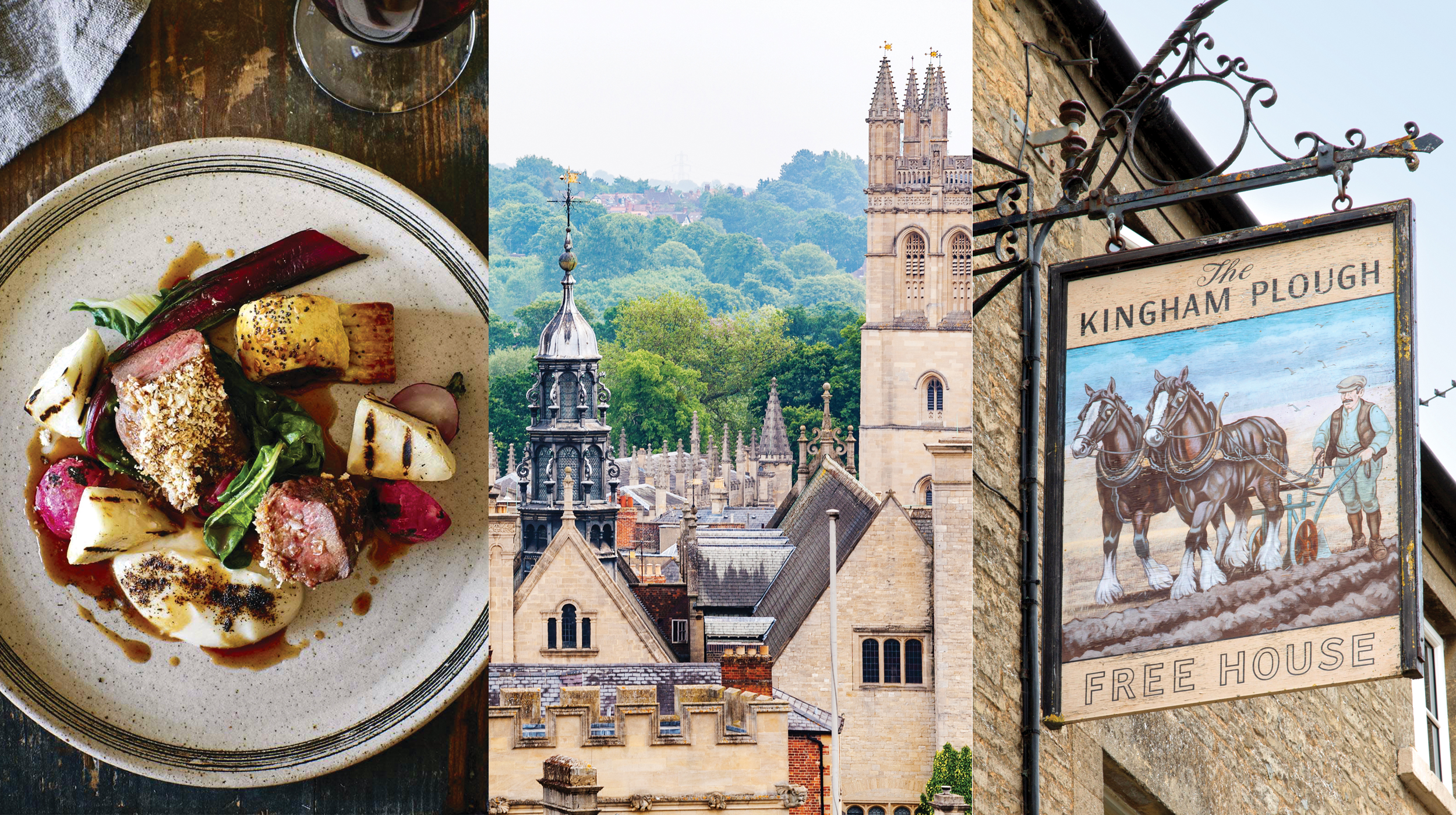Wandering through the nearly 250-year-old Oxford Covered Market, with its pink painted ceiling and cast-iron lamps, I didn’t expect to be mesmerized by a piece of porcine history. But now I can’t stop staring.
Suspended by a thin wire and housed in a polished glass terrarium, the little black nubbin is the prized possession of butcher M. Feller Sons and Daughter. Imported from Chicago in 1892, the ham owes its longevity to being cured in borax. The butchers think it might still be edible, but no one is willing to give it a taste. It’s one of very few inedible things in this venerable market.
Over at Brown’s Café, patrons line up for the all-day full English breakfast. At butcher David John’s stall, whole pheasants, partridges and pigeons are displayed like fleshy gems beside a glistening platter of venison kidneys. The selection isn’t surprising when you consider the place started out as a game butchery back in the 1800s.
I stop to admire the display case at The Oxford Cheese Company: Isle of Mull Cheddar, Cornish Yarg, Red Leicester and, of course, Oxford Blue. “Have a taste,” says the cheesemonger, handing me a slice, “it’s like a blend of Camembert and Stilton.” I can’t resist.
This is why I’ve come to Oxfordshire, after all: To get a taste of traditional English cooking at its source. Twenty years ago, British cooking was typically served up as a punch line. But then a group of dedicated chefs started to revive old recipes, adapting and evolving them using quality seasonal ingredients. Today, traditional English food is recognized as some of the world’s finest and the farms and pastures around this famed university are among the U.K.’s best.
To further my culinary education, I drive out to the Mason Arms in the village of South Leigh. The Arms, a typical old English pub, has been updated as a stylish restaurant and hotel. Like the decor, highlighted by pink velvet banquettes and neon artwork, the menu plays with expectations.
MORE TO READ
Lisbon for foodies: Exploring a culinary capital, bite by bite
There are fish and chips, Scotch eggs and Sunday roasts, of course, but it’s the slightly more adventurous cooking that really showcases the kitchen. Slender mackerel fillets, seared to a skin-blistering char, are offset by fresh fennel salad and dill crème fraîche. A trembling, pan-roasted cod loin balances on plump heritage potatoes seasoned with the liquor from steamed clams and a tangle of sea vegetables. The fresh ingredients coupled with the expertise of the technique make this meal the polar opposite of stodgy pub food.
When executive chef Liam Whittle comes by to check on things, I inquire about the return of English cooking and how Oxfordshire has changed. “A lot of the post-war population didn’t really care about food,” he explains. “Although these dishes never truly went away, they definitely fell out of favour. But now they’re back on our dinner tables, which is really great.”

Back in the city of Oxford the next morning, I pop into Turl Street Kitchen. The place is filled with simple wooden tables and chairs, some of which have little shelves on their backs to hold books. Over the hiss of espresso machines, university students tap away on laptops; disheveled professors sip cider between bites of vegan granola. The overheard conversation is scintillating: “She died of a broken heart in 1524,” one patron says. “The parallels between Herman Hesse and the teachings of the Jesuits are fascinating,” says another.
The eavesdropping is educational, but the food is even better. I order the full English: poached eggs with golden yolks spilling into grilled field mushrooms; braised tomatoes for a sense of virtue on a plate brimming with seasoned sausage; smoked bacon and buttery sourdough toast.
A breakfast like this requires a long walk afterward, so I spend the day strolling through the city and working up an appetite for dinner at The Perch, a historic riverside pub just outside of town. There’s been a working pub here for 800 years, but a major renovation in 2015 secured the structure while keeping the classic bones in place.
Over a pint of Binsey Hoplar, an amber ale made with hops grown on the grounds, I chat with chef Craig Thomson about rediscovering traditional English cooking. “As these kinds of places change ownership, strange things can sometimes happen,” he says. “It’s funny—people can see this beautiful building in this area and decide to do high-end French or Asian fusion. That didn’t make sense to us. So when we took over, we took it back to traditional farmhouse cooking according to the seasons.”
That means things like cider and white onion soup with tarragon sour cream, buttermilk and chive scones, and whole Cotswold partridge with pickled walnuts, smoked bacon and bread sauce. My dessert, Yorkshire rhubarb and custard fool with rhubarb sorbet, is ludicrously good.
MORE TO READ
All roads lead to a self-driving tour of Ireland
The Kingham Plough, just outside the posh and exquisitely named market town of Chipping Norton, is the kind of pub/restaurant other pub/restaurants try to emulate. Sure, it claimed the title of 2019 British Dining Pub of the Year, but it’s more than accolades that set it apart.
At a candlelit harvest table, beside fox- and hen-emblazoned wallpaper, I’m presented with a small, individual loaf of sourdough beside the yellowest butter I’ve ever seen. I slather it on so thick that my bread is nearly half butter—and both are gone by the time the lamb scrumpets arrive. The dish is an old-fashioned recipe for breaded, shredded lamb, served here with anchovy and parsley mayo. Fresh Cornbury Park venison is accompanied by pumpkin, sprouts and cranberry. This is simple, regional cooking executed at the highest level.
“Generally speaking, we’re just trying to trace our roots,” explains chef Iain Dixon. “That’s what guests and diners want. They don’t want their food to travel. There are going to be spices and things that you can’t produce in the country, but people want a good story. They want to hear that the venison was shot last week five miles up the road. And you know what? The food is better for it.”
SEE IT WITH AMA
Romantic Britain & Ireland (Insight Vacations)
A 20-day journey through England, Ireland, Scotland and Wales. See the very best of the United Kingdom, with its wealth of history, dramatic scenery, sacred sites and enduring legends. From bustling London and quaint Oxfordshire to the historic Scottish Highlands and Cornish coast, you’ll fall in love with this magical land.
Contact an AMA Travel specialist online or by calling 1-866-667-4777
